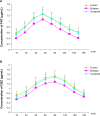P-glycoprotein alters blood-brain barrier penetration of antiepileptic drugs in rats with medically intractable epilepsy
- PMID: 24348021
- PMCID: PMC3857069
- DOI: 10.2147/DDDT.S52533
P-glycoprotein alters blood-brain barrier penetration of antiepileptic drugs in rats with medically intractable epilepsy
Abstract
P-glycoprotein is one of the earliest known multidrug transporters and plays an important role in resistance to chemotherapeutic drugs. In this study, we detected levels of P-glycoprotein and its mRNA expression in a rat brain model of medically intractable epilepsy established by amygdala kindling and drug selection. We investigated whether inhibition of P-glycoprotein affects the concentration of antiepileptic drugs in cortical extracellular fluid. We found that levels of P-glycoprotein and its mRNA expression were upregulated in epileptic cerebral tissue compared with cerebral tissue from normal rats. The concentrations of two antiepileptic drugs, carbamazepine and phenytoin, were very low in the cortical extracellular fluid of rats with medically intractable epilepsy, and were restored after blockade of P-glycoprotein by verapamil. These results show that increased P-glycoprotein levels alter the ability of carbamazepine and phenytoin to penetrate the blood-brain barrier and reduce the concentrations of these agents in extracellular cortical fluid. High P-glycoprotein levels may be involved in resistance to antiepileptic drugs in medically intractable epilepsy.
Keywords: P-glycoprotein; amygdala kindling; antiepileptic drugs; medically intractable epilepsy; verapamil.
Figures



Similar articles
-
Silymarin as a flavonoid-type P-glycoprotein inhibitor with impact on the pharmacokinetics of carbamazepine, oxcarbazepine and phenytoin in rats.Drug Chem Toxicol. 2021 Sep;44(5):458-469. doi: 10.1080/01480545.2019.1601736. Epub 2019 Apr 25. Drug Chem Toxicol. 2021. PMID: 31020859
-
In vivo evidence for P-glycoprotein-mediated transport of phenytoin at the blood-brain barrier of rats.Epilepsia. 2001 Oct;42(10):1231-40. doi: 10.1046/j.1528-1157.2001.01901.x. Epilepsia. 2001. PMID: 11737157
-
MDR1 gene expression in brain of patients with medically intractable epilepsy.Epilepsia. 1995 Jan;36(1):1-6. doi: 10.1111/j.1528-1157.1995.tb01657.x. Epilepsia. 1995. PMID: 8001500
-
Drug transporters in the epileptic brain.Epilepsia. 2007;48 Suppl 1:8-13. doi: 10.1111/j.1528-1167.2007.00993.x. Epilepsia. 2007. PMID: 17316407 Review.
-
ABC transporters during epilepsy and mechanisms underlying multidrug resistance in refractory epilepsy.Epilepsia. 2007;48 Suppl 5:140-9. doi: 10.1111/j.1528-1167.2007.01302.x. Epilepsia. 2007. PMID: 17910594 Review.
Cited by
-
The effect of cannabidiol on the pharmacokinetics of carbamazepine in rats.Naunyn Schmiedebergs Arch Pharmacol. 2020 Oct;393(10):1871-1886. doi: 10.1007/s00210-020-01878-2. Epub 2020 May 19. Naunyn Schmiedebergs Arch Pharmacol. 2020. PMID: 32424477
-
P-gp Protein Expression and Transport Activity in Rodent Seizure Models and Human Epilepsy.Mol Pharm. 2017 Apr 3;14(4):999-1011. doi: 10.1021/acs.molpharmaceut.6b00770. Epub 2017 Mar 2. Mol Pharm. 2017. PMID: 28195743 Free PMC article.
-
Advances in Autoimmune Epilepsy Associated with Antibodies, Their Potential Pathogenic Molecular Mechanisms, and Current Recommended Immunotherapies.Front Immunol. 2017 Apr 25;8:395. doi: 10.3389/fimmu.2017.00395. eCollection 2017. Front Immunol. 2017. PMID: 28487693 Free PMC article. Review.
-
Alterations of Cytochrome P450s and UDP-Glucuronosyltransferases in Brain Under Diseases and Their Clinical Significances.Front Pharmacol. 2021 Apr 21;12:650027. doi: 10.3389/fphar.2021.650027. eCollection 2021. Front Pharmacol. 2021. PMID: 33967789 Free PMC article. Review.
-
Design real-time reversal of tumor multidrug resistance cleverly with shortened carbon nanotubes.Drug Des Devel Ther. 2014 Dec 5;8:2431-8. doi: 10.2147/DDDT.S74962. eCollection 2014. Drug Des Devel Ther. 2014. PMID: 25525333 Free PMC article.
References
-
- Elia M, Amato C, Bottitta M, et al. An atypical patient with Cowden syndrome and PTEN gene mutation presenting with cortical malformation and focal epilepsy. Brain Dev. 2012;34(10):873–876. - PubMed
-
- Elia M, Falco M, Ferri R, et al. CDKL5 mutations in boys with severe encephalopathy and early-onset intractable epilepsy. Neurology. 2008;2371(13):997–999. - PubMed
-
- Capovilla G, Beccaria F, Montagnini A, et al. Short-term nonhormonal and nonsteroid treatment in West syndrome. Epilepsia. 2003;44(8):1085–1088. - PubMed
-
- Loscher W, Potschka H. Role of drug efflux transporters in the brain for drug disposition and treatment of brain diseases. Prog Neurobiol. 2005;76(1):22–76. - PubMed
-
- Potschka H, Loscher W. Multidrug resistance-associated protein is involved in the regulation of extracellular levels of phenytoin in the brain. Neuroreport. 2001;12(11):2387–2389. - PubMed
Publication types
MeSH terms
Substances
LinkOut - more resources
Full Text Sources
Other Literature Sources
Medical

